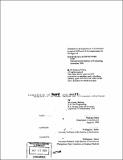Transition of hard and soft : architecture for human, machine and information interchange
Author(s)
Maing, Minjung, 1973-
DownloadFull printable version (4.883Mb)
Alternative title
Architecture for human, machine and information interchange
Other Contributors
Massachusetts Institute of Technology. Dept. of Architecture.
Advisor
Wellington J. Reiter.
Terms of use
Metadata
Show full item recordAbstract
Exchange is the foundation of our specie's existence; and the means of human exchange has been evolving with the fast advancing digital technology. In modem world of new and now, it is no longer simply about delayed transporting as whole the encountering parties from one point to another for the sake of that exchange. Almost instantaneous exchanges with partial displacement of human senses (mainly visual and audio, for now) needed for a meaningful human engagement occur every minute on our planet. Exchange now more than a flight across the Pacific for a business meeting, a train ride to grandpa's country cottage for the holidays, or even a drive across town on a bingo night. It now encompasses faces and voices in the form of anonymous streaming bits of data over invisible and ethereal mediums. Architecture, as an inherently slow-moving discipline, has not been evolving commensurate to the rapidly changing conditions. Airports are still built just for plane travel, subway stations continue to be built only as stops for the trains, and department stores with huge car lots contemporary model of mass exchange; the "market" -- are built for no other purpose than to provide a mere setting for physical transport of the encountering persons and their goods. Modem human living in what may be outdated urban settings demands accessibility to multiple resources and forums in the form of hybrid architecture. Architecture that can not only incorporate the earlier outlined different modes of exchange but which is capable of fast transformation or adaptation to respond to the rapidly altering demands. Such architectural philosophy can rejuvenate the old, existing infrastructure and efficiently preclude our built environment from total obsolescence. The old, inefficient infrastructure will then be a point of departure towards an environment full of multi-level exchanges via multi-purpose complexes. My intentions were to utilize a reworked form the most basic building element - the building skin - and new building surface concepts to arrive at such architecture.
Description
Thesis (M.Arch.)--Massachusetts Institute of Technology, Dept. of Architecture, 1999. Includes bibliographical references (leave [52]).
Date issued
1999Department
Massachusetts Institute of Technology. Department of ArchitecturePublisher
Massachusetts Institute of Technology
Keywords
Architecture.